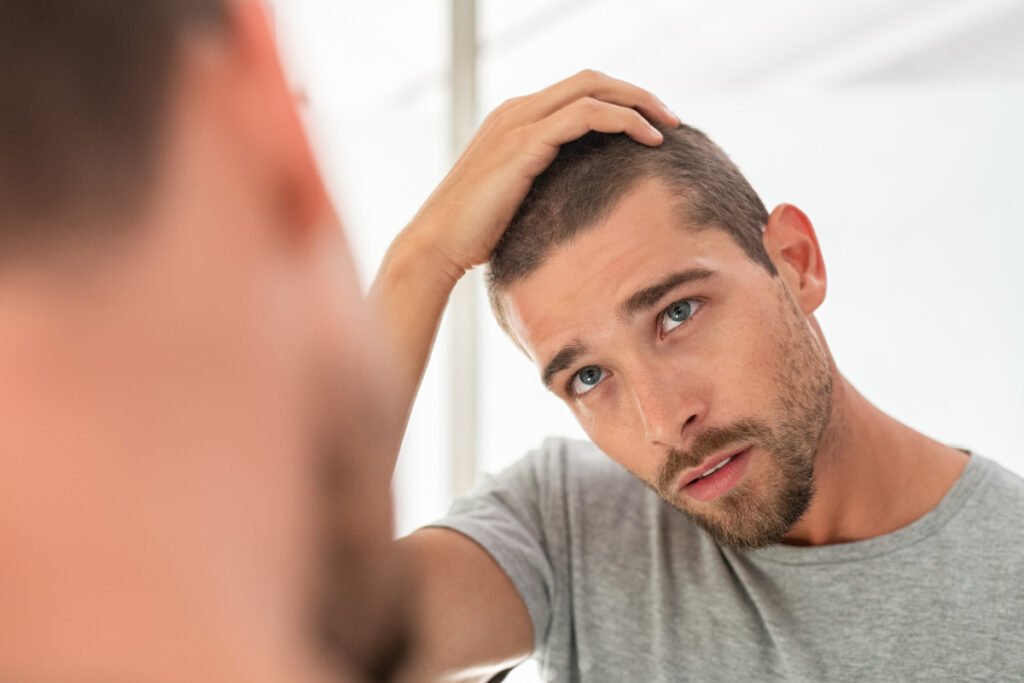
Caring for Your Hair in the Days, Weeks, and Months Following Your Hair Transplant
NeoGraft® hair transplant is the most advanced hair restoration procedure to achieve a fuller, more youthful head of hair for men and women. The minimally invasive technique utilizes Follicular Unit Extraction (FUE) to harvest and implant individual hair follicles without leaving a linear scar, making it an ideal solution for those seeking to address hair loss with natural-looking results and minimal downtime.
But the journey doesn’t end with the procedure itself. Proper short-term and long-term aftercare is crucial for a smooth recovery and ideal results. Here, Detroit cosmetic surgeon Dr. George Goffas outlines the essential aftercare steps for the days, weeks, and months following your NeoGraft hair transplant.
Immediate post-procedure care
For several days following your NeoGraft hair transplant, you’ll need to be especially mindful of your movements so you do not disturb the grafts while also allowing the donor sites to begin healing. Here are some immediate post-procedure protocols:
- Avoid touching, scratching, or rubbing the transplanted area. In the first few days post-transplant, your scalp is the most vulnerable. Even a seemingly harmless scratch can dislodge the delicate grafts.
- Sleep with your head elevated. Swelling is a normal response after surgery, and sleeping in a slightly upright position helps reduce swelling and promotes a smoother recovery. We recommend that you set up your recovery space (and test it out) prior to your procedure to ensure it’s comfortable.
- Wait 24-48 before rinsing your hair. Use only your fingertips and the lightest touch to gently cleanse your hair. Direct water pressure can disturb the newly implanted hair follicles so keep a cup in the shower to gently pour water over your hair to rinse. Lightly pat your hair to dry and avoid letting the comb touch your scalp when you comb over the transplanted area. Do not use a hair dryer or apply any products to your hair or scalp.
- Do not pick at scabs. As your scalp begins to heal, scabs will form over the donor sites and the graft sites after about 48 hours. Picking at the scabs can remove the transplanted hair follicles or cause an infection. This will take some willpower as scabbing can itch.
- Pause your exercise routine. Strenuous activities cause sweating, which increases the risk of infection, impacting the healing process and potentially your results. The increased blood flow can also exacerbate swelling.
Early recovery phase
After about 1-2 weeks, you’ll be able to resume most normal activities. Here are some things to be aware of and aftercare steps to follow during this period:
- Don’t be alarmed if some of the transplanted hair sheds. This is a normal part of your natural growth cycle and not a cause for concern.
- Seek shade or wear a hat outside to protect your scalp from the sun. Your scalp will be sensitive and is still healing. An adjustable hat will ensure the band is comfortable and doesn’t irritate sensitive areas or pull at the grafts.
- Continue gentle care. Keep treating your hair and scalp with care and avoid rough handling to ensure the grafts stay in place. We will clear you to resume your normal hair-washing regimen (using a gentle touch) after about 7 days, and you may apply your normal hair products at this time.
- Allow scabbing to flake off naturally. Scabs will start flaking off about 2 weeks after your hair transplant and you must resist the urge to pick at them or scrub them off in the shower.
- Resume exercise and strenuous activity gradually. Once your scabs are gone, your scalp is healed enough to not be affected by sweat or at risk for unnecessary swelling from increased blood flow.
- Do not dye your hair for at least 6-8 weeks. Harsh chemical treatments like coloring or perming can damage the healing follicles and irritate sensitive skin.
- Attend follow-up visits. We will schedule follow-up appointments to monitor your progress and answer any questions that you may have.
Long-term care
After about 3-4 months post-op, new hair growth should be noticeable, and you will be well on your way to the head of hair you had in your prime. Remember, there are 3 phases in the hair growth cycle: anagen (growth), catagen (transition), and telogen (rest), so full results can take up to a year to manifest. Although your scalp is fully healed, here are some long-term aftercare tips to keep your new head of hair looking sharp:
- Nourish your body with the right nutrients. A healthy diet and staying hydrated help support hair growth.
- Avoid smoking and limit alcohol. Smoking and alcohol have been shown to contribute to hair loss so it’s best to avoid these substances.
- Consider the haircare products you use. Gentle, natural haircare products help maintain the health and vitality of your hair post-transplant. Choose products free of harsh chemicals, sulfates, and parabens that can irritate the scalp or damage hair. Natural ingredients nourish the scalp and newly grown hair more gently and effectively to support the longevity of your transplant results and contribute to the overall health of your hair.
About Dr. George Goffas at Cosmetic Surgeons of Michigan
Are you considering a NeoGraft hair transplant? St. Clair Shores cosmetic surgeon Dr. George Goffas has over 15 years of experience in surgical and non-surgical cosmetic procedures and would be happy to help you regain your confidence with safe and effective hair restoration solutions. To schedule your consultation with Dr. Goffas, please call the Cosmetic Surgeons of Michigan at 586-773-6900 or contact us online today.

Leave a Reply